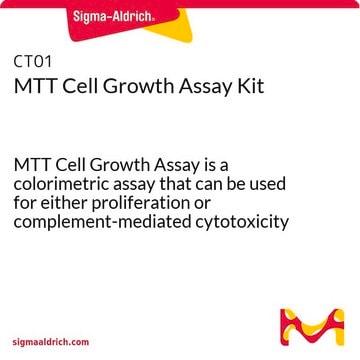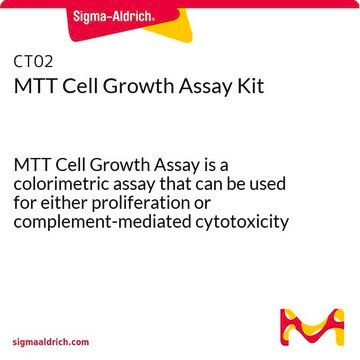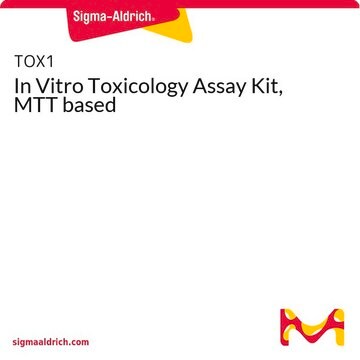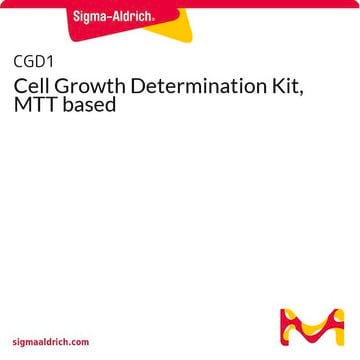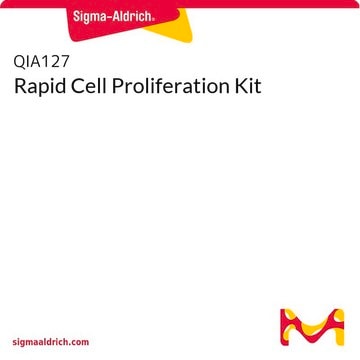Kluczowe dokumenty
11465007001
Roche
Cell Proliferation Kit I (MTT)
Synonim(y):
mtt
Wybierz wielkość
2960,00 zł
Wybierz wielkość
About This Item
2960,00 zł
Polecane produkty
Formularz
liquid
Poziom jakości
zastosowanie
sufficient for ≤2,500 tests
opakowanie
pkg of 1 kit
producent / nazwa handlowa
Roche
warunki przechowywania
protect from light
metody
tissue culture: suitable
λmaks.
550-600 nm
Zastosowanie
cell analysis
detection
metoda wykrywania
colorimetric
temp. przechowywania
−20°C
Opis ogólny
Colorimetric assays analyze the number of viable cells by the cleavage of tetrazolium salts added to the culture medium. This technique requires neither washing nor harvesting of cells, and the complete assay, from microculture to data analysis by an ELISA reader, is performed in the same microplate.
MTT was the first tetrazolium salt described. It is cleaved to formazan by enzymes of the endoplasmic reticulum. This bioreduction occurs in viable cells only, and is related to NAD(P)H production through glycolysis. Therefore, the amount of formazan dye formed directly correlates to the number of metabolically active cells in the culture.
Colorimetric assay (MTT based) for the nonradioactive quantification of cellular proliferation, viability, and cytotoxicity.
Zastosowanie
- Measurement of cell proliferation in response to growth factors, cytokines, mitogens, and nutrients[1][2]
- Analysis of cytotoxic and cytostatic compounds, such as anti-cancer drugs and other pharmaceutical compounds[3]
- Assessment of growth-inhibitory antibodies and physiological mediators[4]
- Testing of biocompatibility of various scaffolds, employed in bone tissue engineering, for bone cell growth[5][6][7]
Cechy i korzyści
- Safe and easy: Eliminate radioactive isotopes, washing steps, and additional reagents.
- Accurate: The absorbance obtained strongly correlates to the cell number.
- Sensitive: Detect low cell numbers.
- Fast: Process a large number of samples using a multi-well ELISA reader.
Cell proliferation and viability assays are of particular importance for routine applications in cell biology. Tetrazolium salts (e.g., MTT, XTT, WST-1) are particularly useful for this type of analysis. Tetrazolium salts are cleaved to formazan by the succinate-tetrazolium reductase system (EC 1.3.99.1) which belongs to the respiratory chain of the mitochondria, and is only active in metabolically intact cells (see below).
Opakowanie
Uwaga dotycząca przygotowania
After thawing, the MTT labeling reagents may be stored protected from light at 2 to 8 °C for up to 4 weeks, in which case reagent filtration through a 0.2 μm pore size membrane is recommended.
Tylko elementy zestawu
- MTT Labeling Reagent
- Solubilization Solution
produkt powiązany
Kod klasy składowania
12 - Non Combustible Liquids
Klasa zagrożenia wodnego (WGK)
WGK 2
Temperatura zapłonu (°F)
does not flash
Temperatura zapłonu (°C)
does not flash
Wybierz jedną z najnowszych wersji:
Masz już ten produkt?
Dokumenty związane z niedawno zakupionymi produktami zostały zamieszczone w Bibliotece dokumentów.
Klienci oglądali również te produkty
Produkty
Cell based assays for cell proliferation (BrdU, MTT, WST1), cell viability and cytotoxicity experiments for applications in cancer, neuroscience and stem cell research.
Testy komórkowe do proliferacji komórek (BrdU, MTT, WST1), żywotności komórek i eksperymentów cytotoksyczności do zastosowań w badaniach nad rakiem, neuronauką i komórkami macierzystymi.
Protokoły
MTT assay protocol for measuring cell viability, proliferation and cytotoxicity. Instructions for MTT reagent preparation and examples of applications.
Protokół testu MTT do pomiaru żywotności, proliferacji i cytotoksyczności komórek. Instrukcje przygotowania odczynnika MTT i przykłady zastosowań.
Nasz zespół naukowców ma doświadczenie we wszystkich obszarach badań, w tym w naukach przyrodniczych, materiałoznawstwie, syntezie chemicznej, chromatografii, analityce i wielu innych dziedzinach.
Skontaktuj się z zespołem ds. pomocy technicznej

